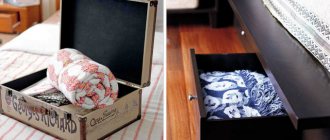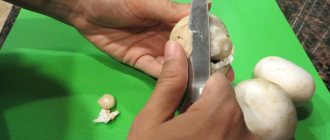Belts and belts are an integral part of the wardrobe. And it often happens that It’s difficult to find them among the piled-up accessories.
The following organization systems have been invented for storing belts: special hangers, hooks, pull-out containers and drawers in the closet.
In this article we will consider the advantages and disadvantages of such systems.
@livesimplybyannie.wordpress.com
In the closet
There are built-in crossbars for belts on the wardrobe doors and walls. You need to push one end through. The method is suitable for ties, thin scarves, and shawls. Disadvantage: limited space. Accessories touch, wrinkle, interfere with trousers and shirts on hangers. A large number of belts will not fit.
An alternative option is hangers, organizers, brackets, boxes. They are placed on shelves, hung in linen sections of closets and dressing rooms.
How do you store your belts?
On a roll Hanging
Belts are stored in organizers and boxes. Not all belts are suitable for twisting; creases appear. In this case, choose special hangers and cabinet brackets.
Other interesting inventions
Since humanity cannot in any way be accused of a lack of imagination and resourcefulness, a large number of various “masterpiece devices” have already been invented. Getting to know them gives you a chance not to buy ready-made products, but to create them yourself, and with minimal losses for your wallet (or card). Some of the inventions are simple, but they perform their function flawlessly. Of course, not every one of them is a hanger, but every model is created specifically for belts.
Hanger with clothespins
This device is also quite simple to make. It is enough to find clothespins (original wooden products are optimal), and then securely glue them (screw them with self-tapping screws) to the hanger, fix them and dry them. For thin plastic products with a narrow crossbar, large clothespins are suitable. You don’t even have to glue such elements, because they are quite simple to put on. You can store any small things on the simplest structures - light scarves, gloves, socks.
Commonwealth of Hanger and Rings
The previous designs were answers to the question of how to make a belt hanger with your own hands. In this case, the master will have to do practically nothing. Especially if the household has a wooden hanger, and the rings left over from the shower curtain were also saved. If there is no NZ (emergency reserve), then you will have to buy them. Even the most “antediluvian” plastic models will do. They are put on the bottom bar of the hanger, and this is where the “hard work” ends. These devices are even suitable for storing clothes or hats: for example, sleeveless T-shirts, baseball caps.
Storage for belts made from boards
Since belts can hang without the aid of conventional clothing structures, other simple options need to be considered. One of them is a hanger made of a block (a narrow board) and clothespins. The easiest and fastest way to get the desired item is to take a board, then glue wooden clothespins to it. The product can be mounted on the door or wall of the wardrobe, or turned into a hanger using a cord and hook. Another possible combination is a board (furniture panel) and hooks.
Inch hangers
This invention can be called the most original design, since to make such models the author only needs paper clips. If we talk about belt hangers, then the smallest office supplies still cannot be considered. However, their large counterparts are quite suitable for storing narrow products. These mini hangers will need their own rod. It can be made from thin tubes, the same chains.
Option for tough men
Not every master will dare to undertake such a “feat against aesthetics”, but for the sake of interest you can still get acquainted with this method. In this case, “supermaterial” is used - a plastic pipe of such a diameter that a rolled belt (125 mm) can easily fit in it. It is cut into small fragments (100 mm), which are sanded and then glued to the cabinet wall from the inside.
Now the question of how to make a belt hanger with your own hands can be considered more or less considered, because there are enough samples for creativity. It is up to the author to decide which one to prefer. You can get acquainted with some options if you take the time to watch this video:
Video loading...
Storage in drawers and compartments
Belts can be stored in small boxes. They are in cabinets, chests of drawers, nightstands. Sometimes furniture makers specifically make compartments for small wardrobe items. They prevent tangling and help maintain order.
How to organize storage:
- Individually roll each belt around your hand.
- Remove from hand. Insert the free end into the hole. You will get something like a node.
- Place it in a box for storage.
The downside is that the method is not suitable for storing hard, thick belts. Silk and satin belts made of slippery material will not hold their shape. The solution is to install dividers, boxes, and containers in the compartments.
Things according to the season
Items that are not suitable for the season are recommended to be removed immediately. You can use a separate compartment for this if the size of the dressing room allows. You can also use mezzanines and chests of drawers. Chunky jackets can be stored away in storage compartments in sofas and beds.
Related links: Kitchen trailer - how to properly decorate the interior
On hooks or hangers
Furniture makers and home goods manufacturers have come up with ways to store belts and belts in a closet. They developed special hangers. The structures differ in shape, size, and fastening device.
Let's look at the main types:
With hooks. They are located on the crossbar. It is convenient to hang a large number of belts from the buckles. We do not recommend doing this behind the holes. They stretch and tear. Do not hang belts over the hooks. Folds and creases form.
Connected rings, squares, honeycombs. Designs with holes are used for belts, sashes, silk scarves, and scarves. Not suitable for hard materials. They bulge, interfere with other things, and it’s difficult to maintain order. Items should hang freely.
With clothespins . Storage option for belts and belts. Suitable for all types with or without buckles, or made from slippery materials. The exception is soft padded fabrics. Creases and marks from clothespins form;
You can make hangers with hooks and clothespins yourself. All parts are sold in hardware/construction stores.
Storing belts on hooks and in a box
How to properly store ties?
Ties are an important part of any business person's wardrobe. Often accessories are specially selected to match different dresses and shirts, and are sometimes made from very expensive materials. Either way, I want every tie to look its best for as long as possible. Therefore, special attention should be paid to the issue of their preservation.
Many men hang their ties in the closet with the rest of their clothes. This archiving option is acceptable. For accessories you need to purchase special tools.
They should be hung separately, and not on the same hanger as a jacket or shirt. If you ignore this point, the products will quickly lose their shape. The fabric will wear out, dry out, and fold.
You shouldn't even put these wardrobe items in a drawer.
Please remember that you should not iron ties with an iron. To give the crumpled product the correct shape, use a special device.
To save yourself from everyday worries related to your wardrobe, it is best to store your items correctly. This way, you'll always have ties on hand, ready for the perfect look.
Let's consider options for placing such accessories.
A special hook is useful for those who have many different ties. This is a hook design. With the help of the latter, the product is fixed on a rod in the closet.
The object may take the form of a long vertical bar with holes for accessories, a wooden hanger with metal supports, a horizontal plastic frame, etc.
- There are many design options.
Some products are versatile and can also be used to store belts. Others are for ties only. In this case, the neck fittings can be placed on the product in one, two rows or in a circle (depending on the design features). The choice depends on personal taste.
A luxurious box made of precious wood will be an excellent storage for expensive accessories. Such products are divided into several identical compartments. Of course, there is a soft lining inside to prevent damage to the fabric.
Each tie is rolled up and stored in a separate compartment. To do this, take the product and place its narrow part between the index and middle fingers. So you have to make a circle around two fingers. It turns out a clean roll.
This storage method is especially preferable for wool products (they lose their shape when hung). The box lid can be transparent or solid. There are one- and two-story buildings for sale. There are boxes in which one “top” is for ties, and the other for small accessories (watches, cufflinks, rings, etc.).
Such boxes not only protect wardrobe items from dust and dirt, but also look solid and are pleasing to the owner’s eye. In addition, such products are compact and mobile - they can be placed anywhere in the dressing room or closet.
A similar organizer with tie compartments that roll up is also available in other materials. Budget options include plastic and fabric models. They can also be placed anywhere. If necessary, you can buy several identical products and stack them on top of each other.
Plastic boxes are more stable. They can be washed periodically (if necessary) and cleaned of dust. In addition, they keep their shape better.
Options made from thick fabric and cardboard come out faster.
If you often travel for work or just travel, you cannot do without a special travel case for ties. Modern manufacturers offer options designed for one accessory and models designed for 2 products.
The former usually take the form of a compact round or rectangular case into which the tie is folded. The latter are more like a school pencil case. When open, they provide a surface onto which accessories are secured using narrow straps with buttons.
The product is then closed (like a book) and zipped.
Therefore, there are various devices that help keep ties in perfect condition. When choosing the right option, you should consider the purpose of the purchase (storage at home or on the go), location (on a bar counter, in a drawer, on a shelf), as well as financial capabilities (both are expensive and budget organizer templates for sale).
The following video shows the basic ways to store ties.
On brackets
Bracket - hanging holder. It is fixed on the wall or rod of the cabinet. It is a structure of crossbars and hooks. The rods are arranged horizontally, vertically, in the form of a sun with rays.
Pros of brackets:
- capacity;
- compactness;
- location options;
- cheapness;
- easy to find and get the right accessory.
Minuses:
- difficult to find on sale;
- you need to attach it to furniture, drill holes;
- does not stick to glue;
- many unsuccessful models.
There is a risk of damaging other wardrobe items with which belts and belts will be stored next to them. It is advisable to choose brackets with blunt hooks. We recommend checking the material of manufacture. Soft metal bends and sag over time. The holder must be supplied with screws and fastening means.
A few more ideas
You can store belts and waistbands in a rather original way. One creative way to store accessories involves using a regular garden rake. They unscrew the handle. And the metal part with teeth is attached to the wall so that various objects can be hung on them, including bags, keys, etc.
Hanging sections made of fabric can be used for interiors in different styles. Choosing an option that fits perfectly into the space of the room is not difficult these days. And it’s not at all necessary to hide them inside the closet.
But this option for storing wardrobe items also has its downside. The belts will need to be pre-twisted, which will not have the best effect on the safety of the artificial leather.
In boxes
Boxes are easy to use for storing belts. Containers will do. They are installed in drawers, on free shelves.
Storage instructions:
- Roll the belts. Secure with an elastic band. Or wrap the free edge of the accessory.
- Place the rolls vertically in rows in a box.
- Place on a shelf for storage.
The downside is that it’s difficult to get one item. The other straps need to be moved apart. Belts often fall out, creating a mess. The solution is to make partitions from thick cardboard or fiberboard.
There are ready-made plastic dividers on sale. They often have a prefabricated structure. This makes it possible to select the quantity and size of storage cells.
Organizers for accessories
Let's figure out how and where to store scarves and belts so that they don't get lost or tangled. Most scarves can be stored away in drawers. Silk scarves can be folded into a square or hung on special structures. Accessories that have a different texture can be rolled or shaped into a ball. They can be placed in special organizers for scarves and belts
Organizing the belts is not difficult at all. Organize them by color and type. It is most convenient to store them twisted into “coils”. Keep your belt buckles on the outside. This way you will be sure that the accessories will not be damaged. Place an elastic band around your waist to prevent the spool from unwinding.
If the texture of the belts is not very hard, then they can be tied into beautiful knots and placed in a basket. It is not only convenient, but also beautiful. You can put accessories in drawers, boxes or trays. Another great way to store belts is to hang them on devices that resemble regular hangers.
The most elegant way to store belts is to use retractable brackets
. They are inexpensive and can easily be built into a wardrobe. In a large dressing room, you can provide pull-out compartments. You can store not only belts in them, but also, for example, ties.
Many furniture manufacturers offer us retractable modules
which have a large number of branches. A more economical alternative is a set of special chest boxes. You can store scarves, jewelry and even linen in them. Women will definitely appreciate this device. Men use these compartments to store ties and socks.
There are many types of organizers: organizers for scarves and belts, special models for tights, jewelry, children's toys and other things. The size, shape and color can be selected individually for each dressing room. The variety of these devices allows you to choose not only a functional item, but also a stylish decorative element that can become an original highlight of your dressing room. Organize your closet with ideas from the WESTWING shopping club.
Original ideas
Don't know how to conveniently store belts? There are also several very original options. For example, you can use a regular garden rake. To do this, you need to unscrew the handle from them and hang this gardening tool on the wall in the hallway so that its teeth point upward. These unique hooks can be used to hang belts, waistbands, bags and more.
If you don’t have a single free hook or drawer at your disposal, then you can make a hanger for belts from scrap materials that are sure to be found in every home.
For these purposes, you can use a thin metal clothes hanger, attaching straps to its bottom edge using regular clothespins. Another option is to take a thick wooden hanger and screw the required number of screws onto it, on which the corresponding products will then be hung.











